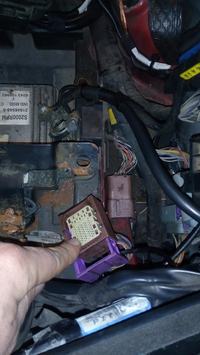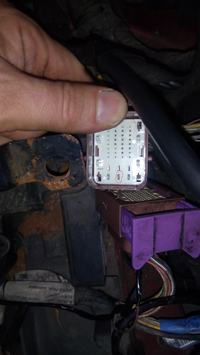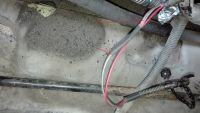Hello
I recently carried out such an operation using the posts of "bombelll" and "eLolek" users, who I would like to thank.
The problem is the lack of switching on the clutch compressor or the problem with driving the variable capacity valve of the Harrison V5 compressor.
The most common cause is the break in the electrical installation, which in this car is probably made of pinworms. How to find out I will describe it immediately, using my own problem.
The first thing I did was visit the plant from klimy. Checking the tightness + if necessary filling the cavities. My problem did not concern the pressostat, so I'm not talking about it in the description. The pressure is, after turning on the button, the revs increase slightly but the compressor does not start.
The first thing - under the car, we remove the ankle from the compressor clutch (the one closer to the belts) and try the clutch (coil) for a short time. Pay attention to the connection point + and - (they are marked on the cube). If, for a short time, the clutch does not click, we know that it is to be replaced, but usually the fun does not end there (not Renault).
If the clutch works, using the fact that we are under the car, we start to check the cables - the cable to the clutch is fixed + (controlled by the negative). We take a meter, one tester for mass and the other look for a plus. How cool it is, it does not mean that we have a break in the hose
The same is done with the cable from the variable capacity valve (at the back of the compressor, where the tubes are). Here, too, there is a constant + and a downside control is from the air conditioning panel (in the cabin) by PWM. I do not know why but the usual plus is and the problem is a minus. If both pluses are, then we're starting to test for "minuses".
To do this, remove the air-conditioning panel, then take out the 30-pin cube (the largest one) and check the transition between:
- for air conditioning clutches, pin 15 connector on the panel in the cabin with a minus on the ankle at the compressor (under the hood)
- for variable capacity valve pin 7, connector panel with minus at the solenoid valve plug (under the hood at the compressor)

If we have both pluses and the above test will show minus passages on the cables, then the problem lies in the air conditioning panel. You can try to repair or buy on the second auction website for a replacement (pay attention to the serial numbers).
A more detailed search for the lack of passage on the above mentioned wires can be carried out by disassembling the battery and its base, and matching the connecting bones found there. It's about the two big cubes to the right of the computer (looking under the hood), not the plugs plugged directly into the computer.

I just had a break in the hose to the compressor clutch -> pin 15 (green cable) to the minus connector in the plug (orange cable).
To narrow down the search area, I got used to these cubes. In the bone closer to the computer the passage of this line (to the compressor coil) is on the middle of the bottom thick pins.

Now we can check whether the gap is between the air-conditioning panel and the dice or between the ankle and the compressor. For me, the second option came out, so I did not play with the next search and the beam under the hood - I ran a bypass new lead from the ankle to the plug on the compressor and everything goes on. I am sure that the transitionpin 7 - the compressor valve also passes through this bone, but I did not check for lack of necessity (and laziness).
I recently carried out such an operation using the posts of "bombelll" and "eLolek" users, who I would like to thank.
The problem is the lack of switching on the clutch compressor or the problem with driving the variable capacity valve of the Harrison V5 compressor.
The most common cause is the break in the electrical installation, which in this car is probably made of pinworms. How to find out I will describe it immediately, using my own problem.
The first thing I did was visit the plant from klimy. Checking the tightness + if necessary filling the cavities. My problem did not concern the pressostat, so I'm not talking about it in the description. The pressure is, after turning on the button, the revs increase slightly but the compressor does not start.
The first thing - under the car, we remove the ankle from the compressor clutch (the one closer to the belts) and try the clutch (coil) for a short time. Pay attention to the connection point + and - (they are marked on the cube). If, for a short time, the clutch does not click, we know that it is to be replaced, but usually the fun does not end there (not Renault).
If the clutch works, using the fact that we are under the car, we start to check the cables - the cable to the clutch is fixed + (controlled by the negative). We take a meter, one tester for mass and the other look for a plus. How cool it is, it does not mean that we have a break in the hose
The same is done with the cable from the variable capacity valve (at the back of the compressor, where the tubes are). Here, too, there is a constant + and a downside control is from the air conditioning panel (in the cabin) by PWM. I do not know why but the usual plus is and the problem is a minus. If both pluses are, then we're starting to test for "minuses".
To do this, remove the air-conditioning panel, then take out the 30-pin cube (the largest one) and check the transition between:
- for air conditioning clutches, pin 15 connector on the panel in the cabin with a minus on the ankle at the compressor (under the hood)
- for variable capacity valve pin 7, connector panel with minus at the solenoid valve plug (under the hood at the compressor)

If we have both pluses and the above test will show minus passages on the cables, then the problem lies in the air conditioning panel. You can try to repair or buy on the second auction website for a replacement (pay attention to the serial numbers).
A more detailed search for the lack of passage on the above mentioned wires can be carried out by disassembling the battery and its base, and matching the connecting bones found there. It's about the two big cubes to the right of the computer (looking under the hood), not the plugs plugged directly into the computer.

I just had a break in the hose to the compressor clutch -> pin 15 (green cable) to the minus connector in the plug (orange cable).
To narrow down the search area, I got used to these cubes. In the bone closer to the computer the passage of this line (to the compressor coil) is on the middle of the bottom thick pins.

Now we can check whether the gap is between the air-conditioning panel and the dice or between the ankle and the compressor. For me, the second option came out, so I did not play with the next search and the beam under the hood - I ran a bypass new lead from the ankle to the plug on the compressor and everything goes on. I am sure that the transitionpin 7 - the compressor valve also passes through this bone, but I did not check for lack of necessity (and laziness).




